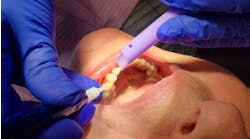Technology versus cost: What your customers are reading this month
by William P. Prescott, EMBA, JD
Editor’s Note: The following article appeared in the May issue of Dental Economics, a sister publication of Proofs. I thought it was important for you to read what your customers have recently read on a topic that may impact you.
The purpose of this article is to share some of my observations on the benefits versus the cost of technology. These observations are based on 16½ years as a dental equipment and supply representative, and the past 19 years as a lawyer representing dentists.
At a recent conference of practice brokers and consultants, a practice broker who also happens to be a lawyer, shared some information about a retiring dentist he knows but does not work with. The practice purchased over $200,000 in technology but could not recoup its cost when it came time to sell it. Unfortunately, this violates rule one of this article.
Rule 1: Retiring dentists should not be spending large sums on technology that may not be used by the purchasing general dentist or specialist. Let the new doctor make his or her own technology purchases.
Now, let’s look at another scenario. A young dentist decides to establish a practice. The equipment purchases for the new facility include substantial new technology. Unfortunately, without sufficient patients, the young doctor faces potential bankruptcy due to the additional debt.
Rule 2: Purchase technology only with sufficient patients in your practice.
The young but established dentist decided to invest almost $50,000 in a digital X-ray system. The dentist was told by the manufacturer’s representative that the system could be removed if it did not meet his expectations, so the dentist purchased it with lender financing. However, the system did not meet his expectations. When the dentist tried to call the sales representative to remove the system, the salesman would not return his calls.
Rule 3: Have your attorney review contracts for the technology to ensure that you understand what you have agreed to.
In this example, it was not written in the contract that the technology could be returned and the purchase price refunded. Also, the company that sold the digital X-ray system was not a dental equipment and supply company. It was a company that this dentist used for a one-time purchase. The dentist was accustomed to working with dental dealers who “make things right” and continually serviced his equipment over his entire career.
My firm represented this dentist, and we were forced to file a lawsuit to get the company to remove the technology and refund the full purchase price. No, we did not charge the dentist $50,000 to get the $50,000 purchase price back. But that could easily happen, so have your attorney review the contract before – not after – you sign it.
Technology and the associate, partner
Now let’s look at technology considerations when planning to hire an associate. Consider this example. The owner dentist is approaching age 60 and wants to relocate the practice to a new building and hire an associate. The associate he hires agrees to buy into the practice, purchasing the first half while the owner-dentist continues in the practice and buying the second half upon the departure of the owner.
The practice owner purchased technology for a rather high cost when the costly office facility was built. The associate could not adapt to the technology, did not want to pay for the use of the technology, and decided to leave the practice. Now the owner must work long hours to cover the overhead and earn a living. At this point, he is searching for a dentist to purchase the entire practice and the building.
The practice happens to be in a problem geographic area where jobs are being lost. The relocation should not have taken place at all, but that’s not our fourth rule.
Rule 4: If you invest in technology and have or plan to have an associate in your practice, limit the associate pool to those dentists or specialists who can or will learn to effectively use and pay for the technology.
One more negative about this practice situation – the building is financed in a way that will require lender approval before the building can be sold to anyone, including a new dentist who will purchase the practice. Not good!
Now let’s look at a partnership. Two partners/shareholders purchase technology that will be used by one of the dentists and not the other. The technology cost is allocated to the dentist who uses it, and the dentist who does not use it is unaffected. Doing this requires a careful allocation of “direct business expenses” by a CPA who is experienced in representing general dentist and dental specialty practices.
Rule 5: Partners may allocate technology on the basis of usage.
Technology and the multispecialty practice
In our next example, a multispecialty practice wants to install expensive technology for implants. We meet with the CPA, who is designated as the gatekeeper, to determine whether the technology is appropriate, and we determine it is. A cost versus benefit analysis is undertaken with the assistance of the specialists who sat with the CPA to determine the number of patients per month who would benefit from the technology, the cost per patient, and how the fees would be paid. We also discuss the commitment of the doctors to follow through on the use of the technology, the planned training of the staff, and overall implementation of the technology in the practice, given the specific facility design. The facility is new. As part of the overall implementation in light of the cost, we analyze patient acceptance and budget a marketing campaign with an outside advertising consultant. So far, so good.
The accountant also determines items such as lease versus purchase, repayment period, interest rate percentage, interest rate calculation, prepayment penalty, accelerated depreciation, expensing deductions and credits, additional fees generated from the technology, personal guarantees, and blanket security issues. But most important – based on the information provided by the doctors to the accountant – the accountant calculated the anticipated return on investment from the technology. This item will be monitored on an ongoing basis and, in this case, we hold semiannual meetings with all advisors.
Rule 6: Involve your advisors in the decision-making process for technology purchases.
Doing the math
As an example, assume that technology in a given practice costs $200,000. It is financed over five years at 8% for an approximate yearly cost of $48,663. If we further assume that this practice maintains a 40% profit margin of owner compensation and benefits in all forms, we would want to maintain the same profit percentage.
$48,663 divided by .6 = $81,105. This represents the additional yearly revenue to maintain a 40% profit margin and pay for the cost of this technology. To maintain the same pay and benefits, the practice would have to collect an additional $48,663.
Rule 7: Authorize your CPA to calculate your anticipated return on investment.
Note that a seven or 10 year repayment period was not used in this example as there is an assumption that the technology will have a useful life of five years.
Rule 8: Match the repayment period for the technology to its useful life.
As an additional example, assume that the practice is planning to add an associate who will hopefully be elevated to ownership after predetermined quality and production objectives are consistently met. Because the facility is too small, the practice must relocate to have sufficient space for the associate. The equipment and build-out cost is $350,000 and will be repaid over 10 years, because we believe the useful life of the equipment and build-out will be at least that long. With an interest rate of 8%, the yearly repayment would be approximately $50,958.
To maintain a 40% profit in all forms, the required additional yearly revenue would equal $84,930. If the $200,000 in technology is also purchased, the required additional yearly revenue to maintain a 40% margin would equal $166,035. For the practice owner to maintain the same pay and benefits, the practice would have to collect an additional $99,621. What your accountant cannot tell you is where this additional revenue will come from. If you believe the nice salesperson who says your revenue will increase due to the technology purchase, you need to take the responsibility to ensure that it does. This requires change!
8 Rules for Purchasing Technology
As a summary, here are the rules for technology purchases based on my experience:
- Retiring dentists/specialists should not spend large sums on technology that may not be used by the purchasing general dentist or specialist.
- Purchase technology only with sufficient patients in your practice.
- Have your attorney review contracts for the technology purchases to ensure that you understand what you have agreed to.
- If you invest in technology and have or plan to have an associate in your practice, limit the associate pool to those candidates or specialists who can or will learn to effectively use and pay for the technology
- Partners may allocate technology costs on the basis of usage.
- Involve your advisory team in the decision-making process for technology purchases.
- Authorize your CPA to calculate your anticipated ROI.
- Match the repayment period for the technology to its useful life.
Commit to using the technology
Over my career, I have seen many offices with technology that was not used well, if at all. The difference between past years and now is that the technology cost is much higher and continually increasing. You need to be committed to using the technology and you need sufficient patients to purchase it. Purchasing technology will probably not bring you new patients without an advertising budget. But all in all, newer technology will continue to be available in dentistry and improve patient treatment. The challenge is that patients need to be educated to understand that quality dentistry is expensive and will probably be an out-of-pocket cost.
William P. Prescott of WHP, Avon, Ohio, is a practice transition attorney, former dental equipment and supply representative, and author. Prescott’s most recent publication, “Joining and Leaving the Dental Practice,” is available on his firm’s Web site, www.wickenslaw.com. He can be contacted by e-mail at [email protected].







